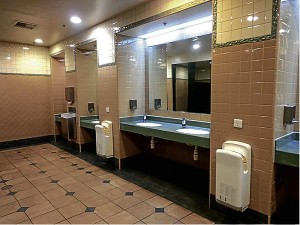Green restrooms

HIGH-SPEED energy-efficient hand dryers and low-flow electronic lavatory faucets are features of green restrooms. photo:A. P. de Jesus & Associates—Green Architecture
Water has no substitute. Our water resources get transformed through the seas and the atmosphere, making detours through plants and animals. The amount of time that a water molecule spends at any one point in the cycle varies from 9 days in the atmosphere to 10,000 years in the Antarctic icecap.
Saltwater comprises 97 percent of water in the planet. Only 3 percent is fresh, two-thirds of which is in icecaps. Only one percent is available for human consumption and use, agriculture and industry.
Groundwater is getting depleted. Half of the world’s water for drinking, washing and irrigation comes from underground. But our sources are depleted by the dumping of toxic wastes and the slow seepage of chemicals through the soil. Untreated human waste is the biggest pollution threat to our water resources.
A typical urban resident uses at least 15 cubic meters of water per annum, more than double the use of the rural resident. As more and more people come to live in the city, sustainable design needs to put sharper focus on water management and natural drainage patterns.
Among the strategies to minimize depletion of water resources through waste and inefficient use, architects, builders and developers today specify low-use water fixtures.
Article continues after this advertisementRestroom a cost center
Article continues after this advertisementSince the restroom does not produce profits, building owners try to minimize the impact of water, electricity, paper, maintenance and waste removal cost.
First, economy of space is determined. Then the number of fixtures and accessories to be placed in the restroom must answer code requirements. The number and sizes of items must be enough to service the number of people who will use the restroom.
The green restroom exhibits efficiency in time, money and energy while having minimum impact on the environment. The fixtures are divided into those that use water, and fixtures used for hand drying.
Restrooms that use potable water impact on energy use, for transporting, treatment and pumping. Less water used means less drainage, less energy for treatment and disposal.
In England they call it the loo. In France it is called WC. In many other countries they call it the restroom. We are probably the only country that alls it CR or comfort room. Ironically, many of our restrooms hardly provide comfort due to lack of basic facilities.
Toe the green line
We all try to toe the green line. In the United States, they have a range of independent green building rating systems including LEED and Green Globe that pay attention to the design and specification of green restrooms.
Here we have Berde of the Green Building Council of the business sector mostly, and GREEN of the Green Building Initiative of the building professional organizations purely.
Restrooms account for half of water use in buildings, of which toilets and faucets consume the biggest amount. High-efficiency toilets with single- or dual-flush use an average flush volume of 1.28 gallons per flush (gpf), 20 percent less water used compared to the old model that uses 1.6 gpf.
High-efficiency urinals with a maximum flush volume of 0.5 gpf consume 50 percent less water than the standard urinal. A most efficient choice is the waterless urinal with a self-draining design and integral odor control.
A lavatory faucet must have a flow rate of 0.8-1.5 gallons per minute to qualify with green standards. The existing lavatory faucet uses 2.2 gpm. Electronic faucets save up to 70 percent water, eliminate the same amount of wastewater, and offer vandal resistance and increased hygiene because of the no touch controls. A low-flow showerhead can reduce the average shower by up to 20 gallons of water.
Recycled paper towels in restrooms represent a green effort and take only 10 seconds to dry the hands. The conventional electric hand dryer takes up 30 seconds to dry hands. The high-speed energy-efficient hand dryer takes only 10 seconds. This is rated higher than the recycled paper towels because of embodied energy in paper towels (energy needed to extract, manufacture, transport, store), plus administrative and maintenance cost that include garbage disposal, not to mention litter in the toilet. The high-speed energy-efficient hand dryer has a less than one-year payback period.
Green restrooms have much less climate change impact or global warming potential. As today’s temperature soars up to over 36 degrees Celsius, green restrooms walk the way directed to us. The low carbon path will cost us a little more today, but will save us much more tomorrow.
* * *
For comments or inquiries, e-mail amadodejesus@gmail. com